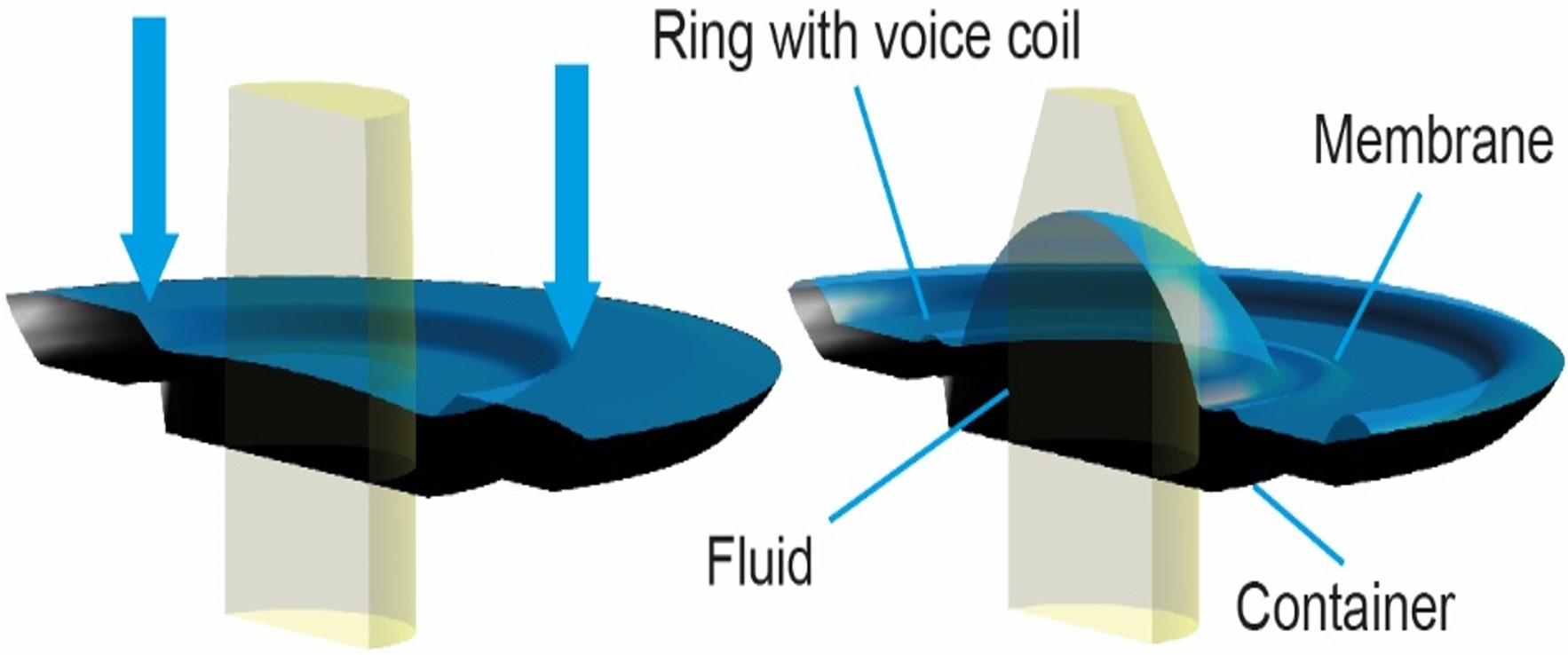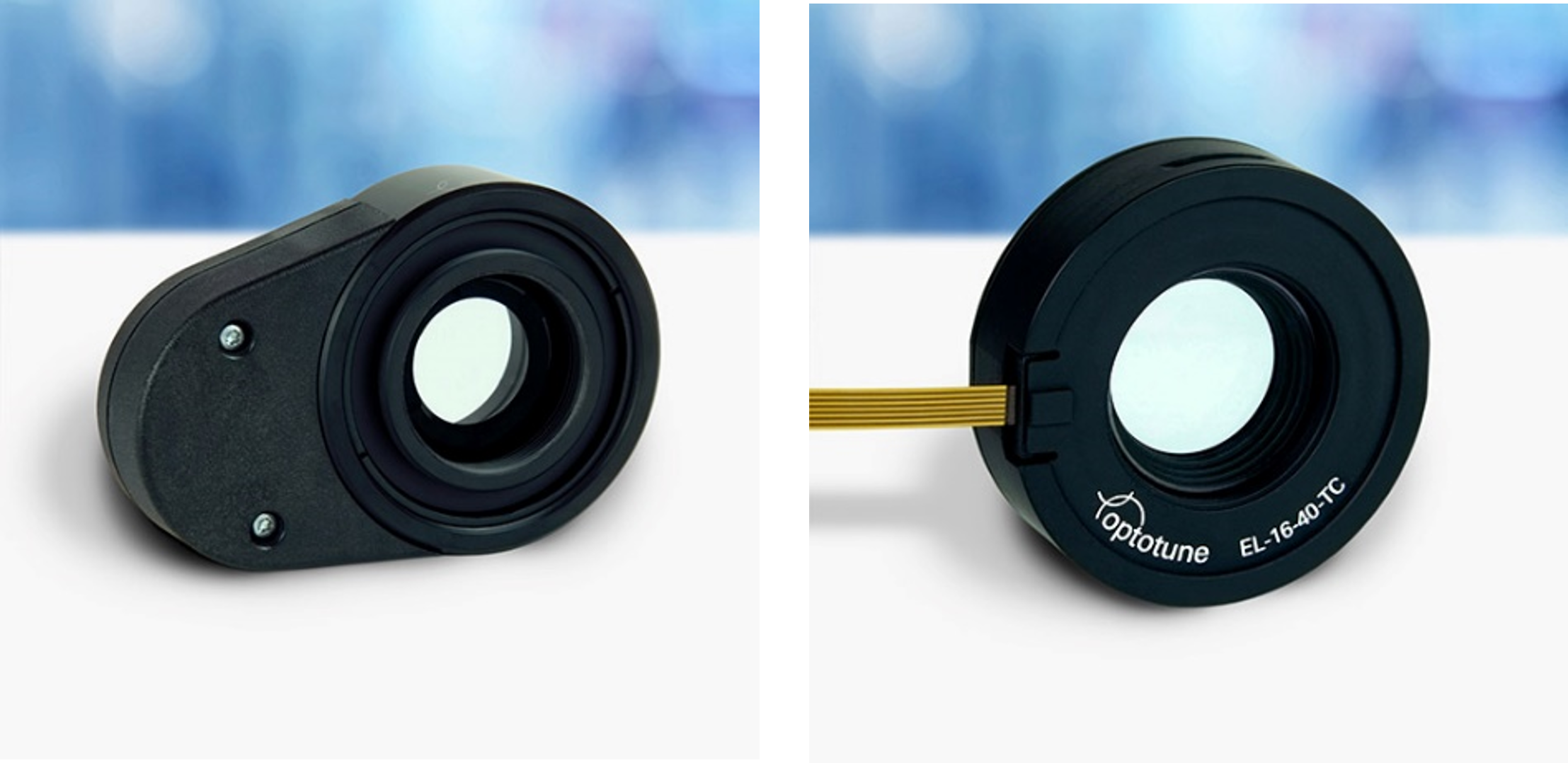Tunable lenses are conceptionally like a human eye. An elastic polymer membrane covers a reservoir containing an optical liquid.
A voice coil actuated system exerts pressure on the membrane outside of the clear aperture. The increasing pressure changes the deflection of the membrane in the optical path as Figure 1 shows, thereby changing optical power. Consequently, the current flow through the actuator is directly proportional to the resulting focal length of the lens.

Figure 1: Working principle of a typical liquid lens. Left: A parallel beam is transmitted through the liquid lens. The arrows indicate where the actuator exerts pressure. Right: When actuated, the curvature of the lens and simultaneously the focal power changes.
To suit a wide range of applications, tunable lenses have been developed with clear aperture sizes from 3mm up to 16mm. The latter allows for combinations with large sensors and enables applications that require image circles of up to 30mm at high resolution. Depending on the size of the lens, focal power can be changed between values within 4ms (3mm clear aperture) to 25ms (16mm clear aperture). Actuation happens virtually without wear, allowing the liquid lenses to focus for billions of cycles and leading to a very long lifetime in the field.
As a core technology in machine vision, Optotune tunable lenses can be used either in combination with off-the-shelf imaging optics or integrated into complete imaging systems with optimized optical designs. For example, Figure 2 shows the EL-16-40-TC liquid lens in both industrial and OEM configurations. This lens, designed into a custom objective to achieve optimal performance, will be used in the iToBoS project to acquire the necessary stacks of images at different focal distances and map the full body of the patient in high resolution. The following examples each illustrate the state-of-the-art setups with an integrated tunable lens for various applications.
 Figure 2: EL-16-40-TC liquid lens with 16 mm aperture. Different mechanical configurations are available based on the requirements of the optical design. Left: Industrial version. Right: OEM version.
Figure 2: EL-16-40-TC liquid lens with 16 mm aperture. Different mechanical configurations are available based on the requirements of the optical design. Left: Industrial version. Right: OEM version.
Long working distance ranges: Placing the Liquid lens in front of the imaging lens
In package sorting applications, the distance of the object to the imaging system changes rapidly and a high-resolution image is required to track bar codes and addresses. Placing the liquid lens in front of the objective leads to a large range of achievable working distances. Vision systems with 8 mm to 50 mm focal length objectives in combination with a tunable lens in the front can image with a wide focal range from infinity (tunable lens at 0 diopters) down to about 200 mm (tunable lens at 5 diopters). Particularly compact systems can be realized in combination with M12 board-camera lenses when the tunable lens mounts directly on the C-mount of the camera.
Short working distances: Placing the liquid lens at the back of the imaging lens
Electronics inspection runs at high speed, requires a relatively large field of view for inspection of multiple PCBs in parallel, and most importantly high resolution to detect tiny production errors. By placing the focus tunable lens at the back of an imaging lens it is possible to achieve high resolution and image circles of up to 30 mm. Between the camera and the C-mount lens, the liquid lens acts like adding a spacer. While this configuration usually provides less optical leverage (smaller working distance ranges) than the front lens configuration it can offer better resolution and reproducibility of the focal plane.
Constant magnification with telecentric lenses
Robotics in precise manufacturing often relies on precise measurements of feature sizes on objects at variable distances from the sensor. Placing Optotune’s liquid lens right after the aperture stop of a telecentric lens creates an imaging system with variable focus at constant magnification.
Optimized designs with an integrated liquid lens
A combination of one of Optotune’s liquid lenses with a standard imaging objective already provides great imaging results. However, designing the liquid lens into the imaging objective from scratch leads to optimal optical performance. An objective with the liquid lens close to the aperture stop achieves larger fields of view, lower f-numbers, and can accommodate large image sensors. In addition, integrated systems are more compact and straightforward to implement in the production line. Recently, Optotune and industrial partners have introduced new lens models for 12 megapixels, 1.1” sensors with focal lengths between 12mm and 50mm. This focal length range can be even larger for smaller sensor formats, reaching extreme values as 5mm or 300mm.
Conclusion
Optotune tunable lenses have been proven useful in a wide range of machine vision applications by replacing multiple imaging systems with one single tunable solution to save space and cost. The lenses enable fast and reliable tunability with billions of cycles enabling universal application in optical systems. Imaging systems with the Optotune liquid lens feature high temporal and spatial resolution. After many applications in machine vision, tunable lenses will be also harnessed to achieve the imaging goals set for the iToBoS project: high-resolution at different focal distances and the fast acquisition of a stack of images.
Optotune AG.
